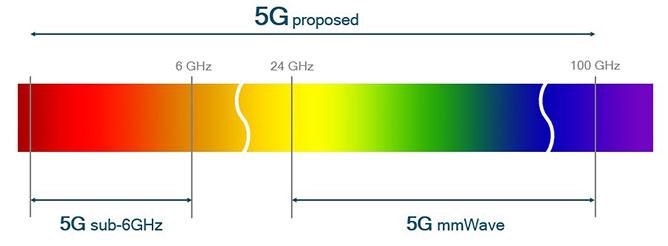FCC’s Spectrum Frontiers will open up 11 gigahertz of mm wave for 5G
The vision for 5G is expansive, but one aspect of it is fiber-like connections providing multi-gigabit per second data rates to mobile devices. This connectivity will make services like 3D telepresence and virtual reality available, but these ultra-high-capacity applications will require mastery of millimeter wave (mmWave) spectrum in the frequency bands above 24 GHz for mobile applications.
The research and development around mmWave and its role in the path to 5G received a major boost in July when the U.S. Federal Communication Commission approved plans to open nearly 11 gigahertz of millimeter wave spectrum in support of mobile telecommunications. The Spectrum Frontiers proposal plans to bring 3.85 gigahertz of licensed spectrum and 7 gigahertz of shared/unlicensed spectrum, in bands ranging from 28 GHz to 71 GHz, in support of 5G.
And while mmWave is poised to support ultra-high-capacity mobile communications, the characteristics of the tiny wavelengths create challenges that need to be solved, as Qualcomm SVP of Government Affairs Dean Brenner points out: “Achieving this use of mmWave spectrum will not come easy since high propagation loss and susceptibility to blockage has traditionally made these higher spectrum bands unsuitable for mobile networks. New advanced 5G technologies, however, will change that.”
A major aspect of mmWave is the opportunity to significantly increase the number of antenna elements—smaller wavelengths require smaller antennas. Beam forming techniques overcome propagation loss by concentrating RF energy in a specific direction.
But, “The challenge for mobilizing mmWave doesn’t end there,” Qualcomm Director of Technical Marketing Matt Branda said. “To enable a good mobile broadband user experience with mmWave requires continuous intelligent beam searching search and tracking to discover and switch to the dominant beam path. This dominant beam path will be constantly changing based on environment, mobility, and a slew of other factors. The real challenge comes in delivering a robust mmWave design that can actually be feasible in indoor/outdoor mobile deployments.”
To test, demonstrate and trial mmWave design 5G, Qualcomm developed a 5G mmWave prototype system operating in the 28 GHz band, which the San Diego-based company has used to conduct live demonstrations and facilitate field trials.
While mmWave is certainly going to be an integral part of 5G, it’s important to remember that it’s one part of a broader connectivity fabric that is also designed to support sub-6 GHz frequency bands (Qualcomm has also developed 5G prototype systems addressing this aspect) as well as tight interworking with LTE and Wi-Fi in these lower frequency bands. In fact, the goal of 3GPP’s 5G New Radio (NR) standard [link to Qualcomm/RCR Wireless 5G NR piece], which is being worked on now in earnest, is to define a unified air interface incorporating everything from narrowband internet of things (NB-IoT) to mmWave, designed get the most out of every bit of a wide array of spectrum ranging from below 1 GHz to ~100 GHz.
 “It is the combination of these advancements in 5G technologies,” Brenner said, “in which Qualcomm is leading the way, along with standardization and regulatory efforts to identify and open up 5G spectrum to help drive timely commercial network launches of 5G.”
“It is the combination of these advancements in 5G technologies,” Brenner said, “in which Qualcomm is leading the way, along with standardization and regulatory efforts to identify and open up 5G spectrum to help drive timely commercial network launches of 5G.”
Click here to learn more about Qualcomm’s 5G NR sub-6 GHz prototype system, and click here for more information about Qualcomm’s 5G NR 28 GHz prototype system.
![]()

